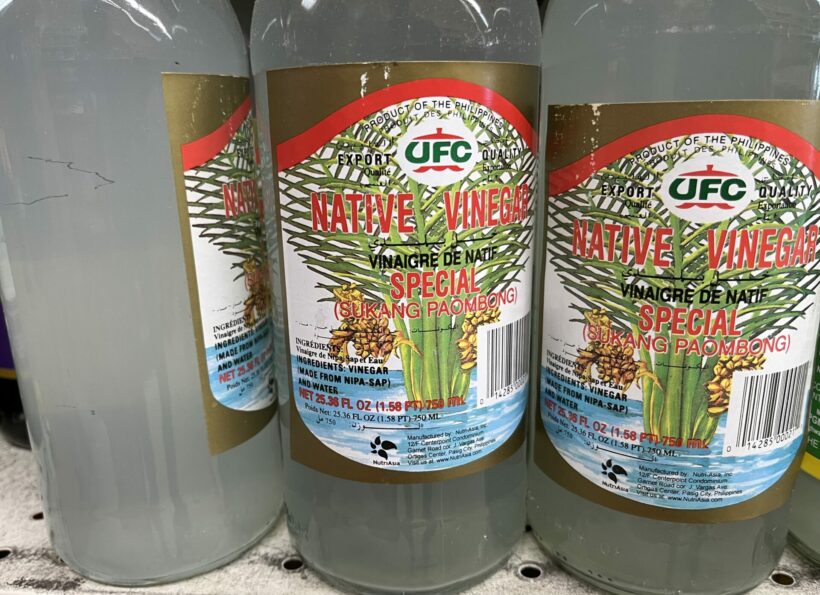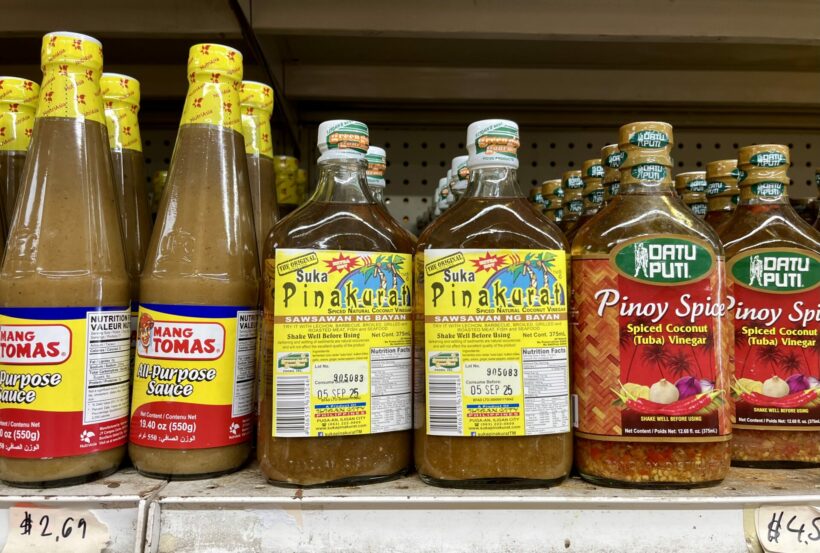The Fourth Episode of Netflix's "I Love Filipino" Series Says: "No Dipping, No Eating"
panarmenian
12 Jul 2025, 08:41 GMT+10

When a co-worker found out I grew up in the Philippines, he could not stop enthusing about the parties Filipino Americans throw here in the U.S. He gushed over "lumpia" spring rolls and "pancit" stir-fried noodles. As a frequent Latino guest at these feasts, he knew how Filipinos love to eat and entertain. But he got serious and asked, "I don't understand though... why do you like eating bland clumpy rice?" Having lived here long enough, I knew the American preference for fluffy, seasoned rice. Still, the question caught me by surprise. And I did not have a good comeback then. Over twenty years later, a Netflix series now provides me answers.
This June, Netflix streamed the "I Love Filipino" series in the U.S. market. Two episodes showcased Filipino food. The first, "Pinoy Altanghap (Filipino Breakfast-Lunch-Dinner)," had host Jiggy Manicad asking chefs and historians what's truly Filipino. Episode four, "Sawsaw Juan," delivered on the title, a play on the word for "dipping sauce" and the namesake of the everyday man. In the episode, Manicad asked guests what "sawsawan" or dipping sauces meant to the Filipino palate and the role they play in the cuisine. Here, he showcased those who stand to benefit from a more global appreciation of Filipino food.

Episode four featured heirloom vinegar makers talking about why regional varieties, like "sukang Iloco" and "sukang paumbong," tasted special. Following tradition, they let sugar cane juice or Nipa palm (Nypa fructans) sap ferment naturally and age in vintage earthen jars, without artificial chemicals.
Proud descendants discussed how matriarch Rufina Salao vda de Lucas fortuitously discovered making "Patis" from fermenting dried fish in "tapayan" earthen jars. They mentioned that adding Rufina fish sauce to any dish "completes" the Filipino dining experience. Also highlighted were multigenerational producers of the pungent "bagoong" fish paste many Filipinos cannot live without. They described the process of salting, fermenting, putting in the "laun" good bacteria, and aging tiny fish or shrimps for up to two years for richer flavor and aroma.
The series host, Jiggy Manicad, interviewed younger generations of the Hernan Reyes family bent on protecting Hernan's legacy of making "Mang Tomas Lechon Sauce." Beloved now as an all-around sauce, it was initially inspired by the tangy liver-based gravy that perfectly matched the fattiness of lechon, the roasted whole pig.
Also in this episode, the family of the late Maria Orosa shared stories of what she accomplished as head of the Plant Utilization Division at the Philippine Bureau of Plant Industry in the 1930s. Orosa developed the now ubiquitous Banana Ketsup to substitute for the American tomato catsup that was in short supply during WWII. Before she passed away from war injuries in 1945, Orosa had revolutionized the Philippine food industry by experimenting with the use of banana, cassava, and coconut as alternatives to flour made from wheat, a crop that does not grow in the country.
So, I pondered. Did the "I Love Filipino" series dedicate one out of its five episodes to vinegar, fish sauce, gravy, catsup, and "bagoong" dipping sauces?
Other themes like contemporary music, visual arts, and Filipino architecture aired only in one episode each. Then I realized that "sawsawan" is the lynchpin of Filipino cuisine. And the term "dipping sauce" does not fully represent the "sawsawan" category of food in the Filipino culinary tradition. The translation fails to capture the broad spectrum of small plates that accompany dishes to enhance flavor, whet appetites, and encourage bingeing. Included here are "pampagana," or "appetite-boosting" sides. As host Manicad claims, nothing beats a side of plump tomato, mashed by hand and not sliced, in taking "pinangat na Tulingan" to the next level. That says a lot because this stew of seasonal "Tulingan" Mackerel tuna packs a punch of umami. It is slow-cooked for at least three hours between layers of sour fruit and pork fat in a clay pot.
Sawsawan, especially those made with fresh, fermented, or pickled fruits and vegetables, function more like salsa in the Mexican and chutney in the Indian cuisines. They do much more than pop an extra layer of sour, salty, hot-spicy, or bitter notes. As the guests of the episode shared, sawsawan allows diners to customize every mouthful to their satisfaction. Moreover, everyone is free to mix and match any or all of these condiments, preserves, and sauces to their liking. To top it all, the ubiquitous "calamansi" or Philippine lime gilds everything with the citrus-orangey tang that Filipinos crave. And apparently, chefs and home cooks take no offense in any tabletop modifications done on their work.
Whether marinating, braising, glazing, or stir-frying with sawsawan, it appears that Filipinos sprinkle only a few drops or a spoonful of sawsawan to pick up the flavor a notch. First, I think the sawsawan itself is bold enough, and second, mother nature's gifts need no embellishments. Filipinos eat less spicy food compared to their Southeast Asian neighbors. Instead, they enjoy the subtle balance of "linamnam" or umami. They can also get away with less complicated cooking techniques. All this is because Filipinos live in a tropical country of 7,641 islands in the Western Pacific Rim. So, seas, rivers, fields, and mountains are only a stone's throw away. Fresh ingredients are plentiful, varied, and accessible. Preferred cooking methods like grilling, frying, or adding water simply bring out the natural sweetness. So, not a lot of spices are needed to cover up extraneous flavors.
When food arrives on the table, dressing in sawsawan keeps rich food from becoming monotonous. Every bite becomes a different sensation. According to Food Historian Felice Prudente Santa Maria, sawsawan also infuses some "wetness" to dishes that are likely cooked well-done. Perhaps an Asian preference, this "wetness" makes a typical Filipino meal of rice and "ulam" easier to chew and more satisfying.
Although episode four translated "ulam" as "viand," a word of French origin, no equivalent to "ulam" exists in the American meal pattern. Dinner in the U.S. consists of an appetizer plate, salad, a main course with sides, and dessert. A meal in the Philippines is "rice and ulam." Rice is the main course and the "ulam" are dishes paired with it. Breakfast, lunch or dinner is not a meal without rice.
Rice, when served for dinner in the U.S., is a side dish. It is no different from mashed potato, fries or salad greens that go with the main course, a protein. But unlike a serving of meat, fish, or seafood for the main course in the U.S, "ulam" may be multiple dishes, including soups, vegetables, and fruit, all served at the same time. Often, a home-cooked meal of rice is served with at least two kinds of ulam. And the meal is served family style, with food shared among diners. In contrast to individual plate serving in America, a meal in the Philippines is never plated. Each diner is free to help him or herself with rice and any combination of ulam.

Enter sawsawan in the picture. Sawsawan that elevates the enjoyment of rice and ulam, together or separately, is welcome to the party. And although sawsawan to the Filipino diner feels like a bonus, it is sorely missed when absent.
At times, sawsawan like "patis" (fish sauce) is the ulam. Manicad, the host, poured gravy for KFC-style fried chicken all over rice because Filipinos do, he said. So, to my co-worker's question on why Filipinos eat rice that's bland. I can now say: because stimulation comes from everywhere else. Unseasoned rice provides the blank canvas for ulam and sawsawan to create magic.
About the Author:

George Banez is a writer of Filipino descent and is a retired non-profit professional living in Florida.
Source: Pressenza
 Share
Share
 Tweet
Tweet
 Share
Share
 Flip
Flip
 Email
Email
Watch latest videos
Subscribe and Follow
Get a daily dose of Philippine Times news through our daily email, its complimentary and keeps you fully up to date with world and business news as well.
News RELEASES
Publish news of your business, community or sports group, personnel appointments, major event and more by submitting a news release to Philippine Times.
More InformationInternational
SectionCDC: US records 1,288 measles cases, most since 1992 outbreak
ATLANTA, Georgia: The United States is facing its worst measles outbreak in more than three decades, with 1,288 confirmed cases so...
Gaza War sucking life out of an Israeli generation
In the past month alone, 23 Israeli soldiers have been killed in Gaza—three more than the number of remaining living hostages held...
Faulty IT system at heart of UK Post Office scandal, says report
LONDON, U.K.: At least 13 people are believed to have taken their own lives as a result of the U.K.'s Post Office scandal, in which...
Travelers can now keep shoes on at TSA checkpoints
WASHINGTON, D.C.: Travelers at U.S. airports will no longer need to remove their shoes during security screenings, Department of Homeland...
Rubio impersonator used AI to reach officials via Signal: cable
WASHINGTON, D.C.: An elaborate impersonation scheme involving artificial intelligence targeted senior U.S. and foreign officials in...
Warsaw responds to migration pressure with new border controls
SLUBICE, Poland: Poland reinstated border controls with Germany and Lithuania on July 7, following Germany's earlier reintroduction...
Business
SectionAI saves $500 million for Microsoft as layoffs reshape strategy
REDMOND, Washington: Artificial intelligence is transforming Microsoft's bottom line. The company saved over US$500 million last year...
FTC’s rule to ease subscription cancellations struck down by court
WASHINGTON, D.C.: A federal rule designed to make it easier for Americans to cancel subscriptions has been blocked by a U.S. appeals...
Musk’s X loses CEO Linda Yaccarino amid AI backlash, ad woes
BASTROP, Texas: In a surprising turn at Elon Musk's X platform, CEO Linda Yaccarino announced she is stepping down, just months after...
Ex-UK PM Sunak takes advisory role at Goldman Sachs
NEW YORK CITY, New York: Former British prime minister Rishi Sunak will return to Goldman Sachs in an advisory role, the Wall Street...
Gold ETF inflows hit 5-year high as tariffs drive safe-haven bets
LONDON, U.K.: Physically backed gold exchange-traded funds recorded their most significant semi-annual inflow since the first half...
PwC: Copper shortages may disrupt 32 percent of chip output by 2035
AMSTERDAM, Netherlands: Some 32 percent of global semiconductor production could face climate change-related copper supply disruptions...













